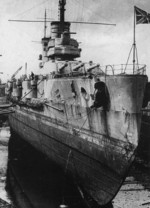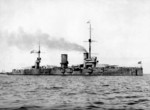Parizhskava Kommuna
| Country | Russia |
| Ship Class | Gangut-class Battleship |
| Builder | Admiralty Yard, St. Petersburg, Russia |
| Laid Down | 16 Jun 1909 |
| Launched | 10 Jul 1911 |
| Commissioned | 30 Nov 1914 |
| Decommissioned | 17 Feb 1956 |
| Displacement | 24,800 tons standard |
| Length | 594 feet |
| Beam | 88 feet |
| Draft | 30 feet |
| Machinery | 10 Parsons steam turbines, 22 Yarrow boilers of three drum type (installed 1938), 4 shafts |
| Bunkerage | 3,000t coal, 1,170t oil |
| Power Output | 52,000 shaft horsepower |
| Speed | 24 knots |
| Range | 3,200nm at 10 knots, 1,000nm at 23 knots |
| Crew | 1,149 |
| Armament | 4x305mm/52 guns, 12x120mm guns, 3x76.2mm anti-aircraft guns, 16x37mm anti-aircraft guns, 12x12.7mm DShK machine guns, 4x407 mm submerged torpedo tubes |
| Armor | 12.5-22.5cm belt, 1.2-5cm deck, 7.6-20.3cm turrets, 7.5-15cm barbettes, 10-25.4cm conning tower |
Contributor: Alan Chanter
ww2dbaseRussia's first dreadnoughts were authorised and put out for contract in 1909. More than fifty designs were submitted with the contract finally won by the German shipbuilding company Blohm & Voss of Hamburg. However the Russian legislative body Duma refused to provide funds unless the ships were built in Russia. The noted Italian naval engineer Vittorio Cuniberti prepared the original design (largely based on the Italian Dante Alighieri) for the Gangut-class, although the Russian Ministry of Marine afterwards insisted on alterations to the plans to include Russian ideas on armouring, ice breaking bows and other special features. Unfortunately, due to Russian industry being unable to provide the high-tensile steel need in quantity for battleships of an indigenous design, the construction became so prolonged that the four battleships, Gangut, Petropavlovsk, Sevastopol and Poltava, would not enter service with the Imperial Navy's Baltic fleet until 1914-15. These Battleships would see virtually no action during World War I and were taken over by the Workers and Peasants Red Fleet (RKKF) following the Bolshevik revolution. ww2dbaseLike her sisters, the Sevastopol was said to be most unhealthy, insanitary and badly ventilated. It also sacrificed protection and endurance for firepower and speed. Her main armament, consisting of twelve 12-inch 52-caliber (305-millimeter) Obukhovskii Pattern 1907 guns situated in four triple turrets, were at the time the longest then at sea. Sixteen 50-caliber 4.7-inch (119-millimeter) Pattern 1905 guns were mounted in casemates as the secondary battery which was intended to defend the ship against torpedo boats. One weakness in the design of the Gangut-class flush-deck battleships with their ice-breaker bows was that they tended to be wet at higher speeds or in a heavy seaway. Similarly the 4.7-inch gun casements were situated so low that they became quite unusable in bad weather. Furthermore, to provide a faster speed the hull design was relatively lighter than in contemporary battleships of other nations.
ww2dbaseIn Mar 1921 the crew of the Sevastopol joined the Kronstadt Rebellion. Her guns engaged the Bolsheviks who had begun to bombard Kronstadt Island and was hit, in return, by three 12-inch shells that killed or wounded 102 sailors.
ww2dbaseOn 31 Mar 1921, after the rebellion had been crushed, the Sevastopol was renamed Parizhskava Kommuna. She was refitted several times before she was once more recommissioned on 17 Sep 1925. She was refitted again in 1928 at the Baltic Shipyard, in preparation for her transfer to the Black Sea Fleet. Her forward funnel was raised and the upper part was angled aft in an attempt to keep the exhaust gases out of the control and gunnery spaces, while three 76 mm M1914/15 anti-aircraft guns were added to the roofs of the fore and aft turrets. She received some additional rangefinders and was given a false bow to improve her sea-keeping ability. She sailed on 22 Nov 1929, in company of the 6,934-ton Light Cruiser Profintern (renamed Krasny Krim in 1939). In the Bay of Biscay they encountered a bad storm which resulted in the battleship being badly damaged by water trapped in the open-topped bow which lacked sufficient drainage. She was therefore forced to put into Brest for emergency repairs, which included the removal of the bulwark that had retained so much water. Both ships finally arrived at Sevastopol on 18 Jan 1930 where the battleship would become the flagship of the Soviet Black Sea Fleet.
ww2dbase
ww2dbaseVice-Admiral Filipp Oktyabrskiy (1899-1969) assumed command of the Black Sea Fleet in Mar 1939 with his flag on the Parizhskava Kommuna. He would command the fleet until 1944.
ww2dbaseIn Feb 1941, during a modernising refit, additional anti-aircraft armament was installed. When Germany invaded the Soviet Union in Jun 1941, the Parizhskava Kommuna was in reserve in Sevastopol. On 30 Oct 1941, she moved to Novorossiysk when the enemy entered the Crimean peninsula. Parizhskava Kommuna would carry out a number of naval gunfire support missions against Axis targets in the Crimea in 1941 and 1942 but thereafter saw no further action as she was judged to be too vulnerable to German air attack. Moving to the safety of Poti in Georgia she reverted to her original name on 31 May 1943 and remained there until late 1944 when she led the surviving vessels of the fleet back to Sevastopol.
ww2dbaseSevastopol would remain in service until 1956. In the late 1940s, in her final configuration she was fitted with British Type 290 and Type 291 air-warning radars. By this time the surviving Gangut-class battleships were all but obsolete, but Joseph Stalin insisted that they should remain in service as a matter of national prestige.
ww2dbaseAwarded the Order of the Red Banner on 8 Jul 1945, the Sevastopol was reclassified as a school battleship on 24 Jul 1954 and was stricken on 17 Feb 1956. She was finally scrapped in 1957.
ww2dbaseSources:
David Porter: World War II Soviet Weapons (Amber Books, 2018)
Tony Gibbons: The Complete Encyclopedia of Battleships and Battlecruiser (Salamander Books, 1983)
Janes Fighting Ships of World War II (Studio Books, 1989)
Wikipedia - Russian battleship Sevastopol (1911)
Last Major Revision: Apr 2019
Photographs
 |  |
Parizhskava Kommuna Operational Timeline
| 16 Jun 1909 | The keel of battleship Sevastopol was laid down at Sankt-Peterburg, Russia. |
| 10 Jul 1911 | Battleship Sevastopol was launched at Sankt-Peterburg, Russia. |
| 30 Nov 1914 | Battleship Sevastopol was commissioned into service. |
| 31 Mar 1921 | Battleship Sevastopol was renamed Parizhskava Kommuna. |
| 17 Sep 1925 | Battleship Parizhskava Kommuna was recommissioned into service. |
| 22 Nov 1929 | Battleship Parizhskava Kommuna and light cruiser Profintern (later renamed Krasny Krim) departed Leningrad, Russia for the long journey to the Black Sea. |
| 18 Jan 1930 | Battleship Parizhskava Kommuna and light cruiser Profintern (later renamed Krasny Krim) arrived in Sevastopol, Russia. |
| 30 Oct 1941 | Battleship Parizhskava Kommuna moved from Sevastopol to Novorossiysk, Russia. |
| 31 May 1943 | Battleship Parizhskava Kommuna was renamed Sevastopol. |
| 8 Jul 1945 | Battleship Sevastopol was awarded the Order of the Red Banner. |
| 24 Jul 1954 | Battleship Sevatopol was reclassified as a training ship. |
| 17 Feb 1956 | Battleship Sevastopol was decommissioned from service. |
Please consider supporting us on Patreon. Even $1 per month will go a long way! Thank you. Please help us spread the word: Stay updated with WW2DB: |
» Battle of Sevastopol
 |  |
- » 1,167 biographies
- » 337 events
- » 44,642 timeline entries
- » 1,244 ships
- » 350 aircraft models
- » 207 vehicle models
- » 376 weapon models
- » 123 historical documents
- » 261 facilities
- » 470 book reviews
- » 28,517 photos
- » 365 maps
General Douglas MacArthur at Leyte, 17 Oct 1944